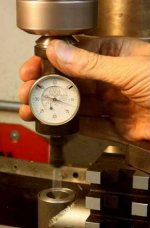Ah yes, tomorrow. That day that never comes. Or at least not as you'd planned it would. I did finish up the tailcap on Saturday. Have to build the light engine for it this week. Here's the one shot I took. Funny that I usually get too involved in the process to remember to take photos...

While it worked, it didn't turn out as clean as I would have hoped. Need to remake this in steel so I can tighten the bolt holding the tailcap more. Otherwise it slips, and causes far more headaches and design recalculations.

While it worked, it didn't turn out as clean as I would have hoped. Need to remake this in steel so I can tighten the bolt holding the tailcap more. Otherwise it slips, and causes far more headaches and design recalculations.










